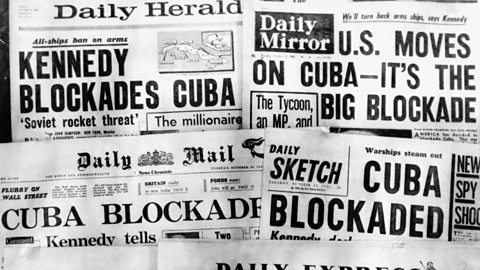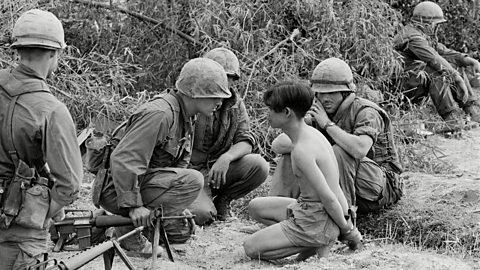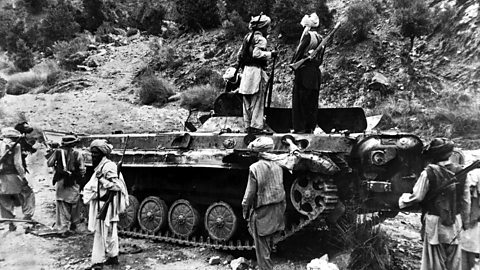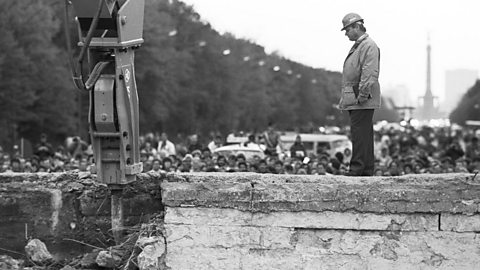Direct confrontation

The Cuban Missile Crisis was probably one of the most dangerous periods of the Cold WarThe political tension and competition for power that existed between the communist East and the democratic West after World War Two. The two sides did not ever go to war. .
For 13 days in October 1962, the world appeared to stand on the brink of nuclear weaponAn extremely powerful explosive device that gets its energy from nuclear reactions. Nuclear weapons are much more powerful than even the largest non-nuclear bomb. Their explosions are so powerful that just one nuclear weapon is capable of completely destroying a city. Nuclear weapons also release huge amounts of radiation, which causes terrible illnesses for a very long time after the initial explosion.war.
This is one of the few examples from the Cold War where the two main superpowerCountries who have huge influence or strength, giving them significant global power. actually came into direct confrontation with the other.
Causes of the Cuban Missile Crisis
Cuba is an island just 90 miles off the coast of Florida.
In 1959, Fidel Castro became its leader.
Castro had overthrown the dictator of Cuba, Fulgencio Batista.
One of Castroâs first moves was to go to the USA to secure support for his new state, but President Eisenhower refused to speak with him.
Instead, Castro accepted the Soviet Unionâs offer of support for his new government.
Castro then nationalisedAn industry or business being taken over by the government. all American-owned companies in Cuba, and refused to pay compensation.
Up until 1959, most of Cubaâs trade in sugar and cigars was with America.
Castro changed this to trade with the USSR.

The actions of the USA
The USA now had a pro-communist state âin its own backyardâ or in their sphere of influenceIn international politics, an area in which one nation holds, or claims to hold, dominant power over a country or several countries.and from 1959-61, they maintained a frosty relationship with Cuba without any direct confrontation.
The Bay of Pigs
In April 1961, just after he was installed as President of the USA, John F. Kennedy approved a plan to invade Cuba and overthrow communismA system of running a country in which all means of production such as tools, factories and raw materials, are owned by the community as a whole. Private property does not exist and each individual contributes according to their ability and receives according to their needs. This means there is no hierarchy of social class..
The CIACentral Intelligence Agency â a foreign intelligence service of the American government, created in 1947 to coordinate and conduct espionage (spying) and gather information about other countries. landed 1,400 Cuban exiles at the Bay of Pigs on the southern coast of Cuba with the aim of provoking an anti-communist uprising.
The rebels were easily defeated when they were met by 20,000 heavily armed Cuban troops.
All were captured or killed.
Kennedy now looked weak whilst Castro looked like a hero in Cuba.
Actions of the USSR
After the Bay of Pigs incident, Cuba clearly felt threatened by the United States.
Therefore, Castro turned to Russia for help and protection.
Nikita Khrushchev agreed to provide Cuba with weapons and missiles for defence.
An agreement was reached during a secret meeting between Khrushchev and Castro in July 1962 and construction of a number of missile launch facilities started later that summer.
Cuba was only 90 miles from the coast of Florida meaning that the USA, including many of its biggest cities like Washington DC and New York, would be well within range of these missiles.
Question
Why did the USSR put nuclear missiles on Cuba?
- To close the missile gap - Khrushchev knew the USA had medium and long-range nuclear weaponAn extremely powerful explosive device that gets its energy from nuclear reactions. Nuclear weapons are much more powerful than even the largest non-nuclear bomb. Their explosions are so powerful that just one nuclear weapon is capable of completely destroying a city. Nuclear weapons also release huge amounts of radiation, which causes terrible illnesses for a very long time after the initial explosion.missiles aimed at the USSR from bases in Turkey, just on the USSRâs doorstep.
- Domestic politics - Khrushchev wanted to strengthen his political position in the USSR and show his government that he wasnât soft on America.
- To protect Cuba - Khrushchev wanted to ensure that the Americans would not attempt to overthrow Castro again.
Reaction of the USA
Within two days of the latest Cuban threat, President Kennedy formed a special advisory group (Executive Committee of the National Security Council or ExComm) to weigh up various options.
After talks with ExComm, Kennedy was faced with a range of options to deal with the Soviet threat in Cuba.
He could:
- Ignore the missiles: The Soviets would see this as weakness on Kennedyâs part, and they would likely take advantage of it.
- Get the United Nations (UN)The successor to the League of Nations, the United Nations was established in 1945 as an international organisation designed to keep peace, uphold international law and set standards in human rights. involved: The USSR would block any UN action so this would be of little value.
- Call on the USSR to remove the missiles: He could do this by explaining the damage their presence was doing to Soviet-American relations.
- blockadeThe act of sealing off a place to stop people or goods entering or leaving. Cuba and not allow any more Soviet ships to enter Cuba: This would still leave missiles on Cuba but the negotiations would continue in the background while publicly Kennedy would be seen to be doing something specific. This risked military confrontation.
- Invade with soldiers or launch air attacks: An unprovoked attack, involving air strikes probably followed by an invasion, would be hard to justify. This would probably lead to Soviet retaliation.
Question
What did Kennedy decide?
Kennedy's final decision was a US blockade of Cuba, which Kennedy called a 'quarantine zone'.
This could stop further Soviet missiles coming to Cuba, buying him time to negotiate with the Soviets.
The key events
| Date | Event |
|---|---|
| 22 October | Kennedy imposes a naval blockadeThe act of sealing off a place to stop people or goods entering or leaving. around Cuba. |
| 23 October | Kennedy receives a letter from Khrushchev saying that the Soviet ships will not stop at the blockade, but will force their way through. |
| 24 October | US ships, submarines, troops and air force were placed on full alert. USSR ships approaching the blockade turn back. |
| 25 October | US spy planes report increased building work at the missile launch sites on Cuba. |
| 26 October | Kennedy receives a letter from Khrushchev promising to remove the launch sites if the USA agrees to lift the blockade and promises not to invade Cuba. |
| Tension increased when a U2 plane was shot down by a Russian missile and the pilot killed. | |
| 27 October | A second letter from Khrushchev says the launch sites will only be removed if the US removes its missiles in Turkey. |
| Kennedy keeps his cool and opts to answer only the first telegram while privately offering to consider the removal of missiles from Turkey. | |
| 28 October | Khrushchev agrees to the removal of all missiles on Cuba and their return to the Soviet Union. |
Consequences of the Cuban Missile Crisis
- Missiles in both Turkey and Cuba were removed.
- Both sides agreed to avoid a future confrontation and set up a direct hotline between Washington and Moscow.
- 1963: Partial Nuclear Test Ban Treaty - this controlled nuclear weaponAn extremely powerful explosive device that gets its energy from nuclear reactions. Nuclear weapons are much more powerful than even the largest non-nuclear bomb. Their explosions are so powerful that just one nuclear weapon is capable of completely destroying a city. Nuclear weapons also release huge amounts of radiation, which causes terrible illnesses for a very long time after the initial explosion. and only allowed tests underground.
- 1969: Treaty on Non-Proliferation of Nuclear Weapons - this prevented more countries from acquiring nuclear weapons.
- Cuba stayed communismA system of running a country in which all means of production such as tools, factories and raw materials, are owned by the community as a whole. Private property does not exist and each individual contributes according to their ability and receives according to their needs. This means there is no hierarchy of social class..
Impact on relations
- The Cold WarThe political tension and competition for power that existed between the communist East and the democratic West after World War Two. The two sides did not ever go to war. did thaw and steps were taken to reduce the risk of nuclear war.
- In order to ensure easier communication between Washington DC and Moscow in the event of future conflict, a hotline was installed giving a direct phone link between the White House and the Kremlin.
- Both the USA and the USSR realised they had been on the brink of nuclear war and entered into talks. These talks eventually led to the 1963 Test Ban Treaty. By 1969, both countries promoted the idea of âpeaceful co-existence.â
- One of the most significant results was that the world never faced this type of crisis again. The Cuban Missile Crisis did pave the way for a period of »ćĂ©łÙ±đČÔłÙ±đEasing of tension - period of time in the 1970s when relations between the USA and Soviet Union improved and there was a reduction in tension. and there was closer co-operation between the superpowerCountries who have huge influence or strength, giving them significant global power. on human rights, nuclear disarmamentThe process of reducing the amount of nuclear weapons a country owns, preferably down to none. and trade.
Test your knowledge
More on International relations, 1945-2003
Find out more by working through a topic
- count9 of 13

- count10 of 13

- count11 of 13

- count12 of 13
